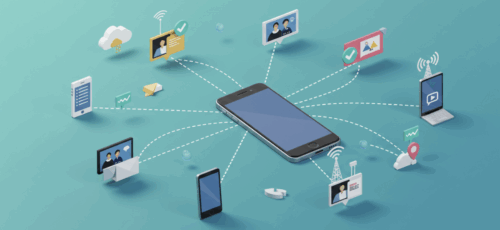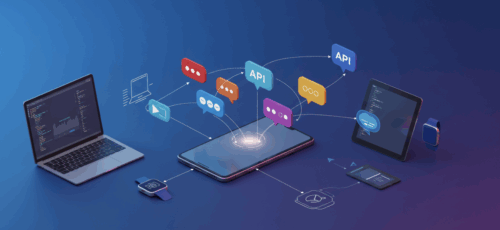CPaaS platforms are transforming from simple API providers into intelligent, AI-powered communication ecosystems that drive real business outcomes.
- AI integration and conversational experiences are becoming standard features, with intelligent automation handling increasingly complex customer interactions.
- Omnichannel unified communications strategies are replacing siloed messaging approaches, creating seamless customer journeys across all touchpoints.
- Enhanced security and compliance frameworks are now fundamental requirements due to stricter data protection regulations.
- Developer-centric platforms with low-code solutions are accelerating implementation timelines from months to weeks.
Smart businesses are adopting CPaaS solutions that prioritize flexibility, security, and scalability to stay competitive.
Traditional phone systems and isolated messaging platforms can no longer support the complex, real-time interactions that businesses require. Communication Platform as a Service (CPaaS) has emerged as the backbone of digital transformation, enabling developers to embed voice, video, SMS, and messaging capabilities directly into applications without building infrastructure from scratch.
According to recent analysis, the global CPaaS market reached $19.1 billion and continues expanding at an impressive pace. This growth reflects how CPaaS trends have transformed from simple messaging APIs into comprehensive communication ecosystems that power everything from customer service chatbots to enterprise-grade unified communications platforms.
What’s Driving CPaaS Trends?
The evolution of CPaaS trends stems from several factors that are reshaping how businesses approach communication technology. Organizations are moving away from traditional, hardware-dependent telephony systems toward flexible, API-driven solutions that can scale dynamically with business needs.
Developer teams face increasing pressure to integrate communication capabilities faster while maintaining security and reliability standards. The shift toward remote and hybrid work models has accelerated demand for CPaaS solutions that can support distributed workforces and provide seamless customer experiences across multiple touchpoints.
Modern consumers expect instant, personalized interactions across their preferred communication channels. Whether customers initiate contact through SMS, voice calls, video chat, or messaging apps, businesses need unified systems that maintain context and continuity throughout the entire interaction journey.
The Rise of Intelligent Communication
Artificial intelligence integration is one of the most significant CPaaS trends reshaping the industry. Research indicates that half of all CPaaS solutions will incorporate AI-driven functionalities by 2025, enabling automated responses, predictive routing, and real-time sentiment analysis.
Smart chatbots and virtual assistants are moving beyond simple keyword matching to understand context, intent, and emotion. These AI-powered systems can handle complex customer inquiries, appropriately escalate issues, and maintain personalized conversation histories across multiple interactions.
Voice intelligence capabilities are particularly transformative. Advanced speech recognition, natural language processing, and real-time transcription services allow developers to build applications that can analyze call sentiment, extract actionable insights, and provide automated coaching for customer service representatives.
How Are CPaaS Platforms Enabling Unified Communications?
Instead of managing separate systems for voice, messaging, video, and collaboration, businesses are adopting business communication API strategies that integrate all channels through a single, programmable interface.
Unified communications eliminate the technical complexity traditionally associated with multi-channel systems. Developers can now embed voice calling, SMS messaging, video conferencing, and chat capabilities directly into existing applications using standardized APIs and software development kits (SDKs).
Breaking Down Communication Silos
Traditional communication systems often create data silos where customer interactions across different channels remain disconnected. Modern CPaaS platforms provide unified contact histories, cross-channel routing capabilities, and integrated analytics that give businesses a complete view of customer engagement patterns.
For example, a customer might initiate support through a mobile app chat interface, transition to a voice call for complex troubleshooting, and receive follow-up instructions via SMS, all while maintaining context and history throughout the entire interaction.
What Security and Compliance Features Are Becoming Standard?
Security and compliance have become non-negotiable requirements in modern CPaaS implementations. With data protection regulations like GDPR, HIPAA, and CCPA becoming increasingly strict, businesses need communication platforms that provide end-to-end encryption, identity verification, and automated compliance management.
Enhanced Authentication and Fraud Prevention
Two-factor authentication (2FA) and one-time password (OTP) delivery have become standard components of CPaaS security frameworks. These authentication mechanisms are critical for financial services, healthcare, and e-commerce applications, where unauthorized access can result in significant data breaches or financial losses.
Advanced fraud detection systems now use machine learning algorithms to identify suspicious patterns, unusual traffic spikes, and potential security threats in real time. These systems can automatically block fraudulent calls, filter spam messages, and alert administrators to potential security incidents.
CPaaS Security Features Comparison
| Security Feature | Implementation Level | Business Impact |
| End-to-end encryption | Standard | Protects sensitive data transmission |
| Multi-factor authentication | Advanced | Reduces unauthorized access |
| Fraud detection | AI-powered | Prevents toll fraud and spam |
| Compliance automation | Built-in | Ensures regulatory adherence |
| Identity verification | Real-time | Enhances customer trust |
Top 7 CPaaS Trends Transforming Business Communication
Market forces are materializing into technological and strategic shifts that forward-thinking businesses are leveraging to gain advantages. The following trends are the most impactful developments reshaping how organizations approach communication infrastructure and customer engagement.
1. AI-Powered Conversational Experiences
Conversational AI has evolved from simple rule-based chatbots to sophisticated virtual assistants capable of handling complex customer inquiries. Natural language understanding (NLU) and machine learning algorithms enable these systems to interpret context, recognize intent, and provide personalized responses that feel genuinely human.
Advanced conversational platforms can now handle multi-turn dialogues, remember previous interactions, and seamlessly escalate complex issues to human agents while maintaining full context.
2. Omnichannel Communication Orchestration
Customers expect consistent experiences whether they interact via SMS, voice, email, or social messaging platforms. CPaaS trends indicate that businesses are moving beyond multiple channels to create truly orchestrated omnichannel experiences.
They’re adopting features like conversation continuity across channels, unified customer profiles that aggregate interaction history, and intelligent routing that directs customers to their preferred communication methods based on past behavior patterns.
3. Low-Code and No-Code Development Platforms
Research suggests that 40% of businesses will adopt low-code/no-code CPaaS platforms by 2026, enabling non-technical teams to build and customize communication workflows.
Drag-and-drop interface builders, pre-built templates, and visual workflow designers allow business users to create sophisticated communication automation without requiring extensive programming knowledge.
4. 5G-Enabled Real-Time Capabilities
The rollout of 5G networks is unlocking new possibilities for ultra-low latency communication experiences. Real-time video collaboration, augmented reality customer support, and high-definition voice calls are becoming accessible to businesses of all sizes through cloud-based APIs.
5G connectivity also enables new use cases like IoT device communication, real-time language translation, and immersive customer experience applications that were previously technically unfeasible.
5. Advanced Analytics and Business Intelligence
Modern CPaaS platforms provide comprehensive analytics that track performance metrics, customer satisfaction scores, and operational efficiency indicators. These insights help businesses optimize their communication strategies and improve customer experience outcomes.
Predictive analytics can forecast call volumes, identify potential service issues, and recommend optimal staffing levels based on historical communication patterns.
6. Expansion and Localization Features
As businesses expand, CPaaS platforms are adding sophisticated localization features, including multi-language support, regional compliance frameworks, and local number provisioning capabilities. These features enable companies to maintain consistent communication experiences across different markets while adhering to local regulations.
7. Enhanced Developer Experience and API-First Design
Developer productivity has become a key differentiator among CPaaS providers. Modern platforms offer comprehensive documentation, interactive API explorers, sandbox environments, and extensive SDK support across multiple programming languages.
The focus on programmable voice APIs and other developer-friendly tools is reducing implementation complexity and accelerating time-to-market for communication-enabled applications.
How Is 5G Technology Reshaping CPaaS Capabilities?
The combination of ultra-low latency, high bandwidth, and improved network reliability is enabling CPaaS providers to offer services that were previously impossible or impractical.
5G Impact on Communication Technologies
| Technology | Pre-5G Limitation | 5G Enhancement | Business Application |
| Video calling | Limited quality, latency issues | 4K video, <10ms latency | Immersive customer consultations |
| Voice AI | Processing delays | Real-time transcription | Live conversation analysis |
| IoT integration | Bandwidth constraints | Massive device connectivity | Smart building communications |
| AR/VR support | Network instability | Stable, high-bandwidth | Remote technical support |
Real-time language translation, previously limited by network delays, now enables instant multilingual customer support experiences. Video-based technical support can provide high-definition, low-latency connections that allow service representatives to guide customers through complex procedures using augmented reality overlays.
Edge computing integration with 5G networks also enables more sophisticated local processing of communication data, improving response times and reducing bandwidth requirements for applications that handle sensitive customer information.
What Role Do APIs Play in Modern Communication Strategies?
APIs have become the building blocks that enable businesses to create customized communication experiences tailored to their operational requirements. Rather than accepting pre-packaged communication solutions, organizations can now assemble exactly the features they need using modular API components.
SIP APIs provide the core infrastructure for voice communications, enabling developers to build everything from simple click-to-call functionality to complex contact center routing systems. These APIs handle the complex technical details of telecom protocols while exposing simple, developer-friendly interfaces.
Messaging APIs enable sophisticated SMS and MMS capabilities that surpass basic text messaging. Advanced features include delivery receipts, message scheduling, bulk messaging with personalization, and integration with customer relationship management (CRM) systems.
Integration Strategies That Drive Results
Successful unified communications implementations focus on strategic integration rather than adding communication features. The most effective approaches involve analyzing existing business workflows and identifying specific communication pain points that APIs can address.
Common integration patterns include embedding voice calling directly into CRM interfaces, adding SMS notifications to existing customer service workflows, and creating automated appointment reminder systems that work across multiple communication channels.
Frequently Asked Questions
What are the main CPaaS trends to watch? The primary CPaaS trends include AI-powered conversational experiences, omnichannel communication orchestration, enhanced security frameworks, 5G-enabled real-time capabilities, and the rise of low-code development platforms. These trends are driven by increasing demand for personalized customer experiences and the need for scalable, secure communication solutions.
How do CPaaS trends impact developer productivity? CPaaS trends toward API-first design and developer-friendly tools are improving productivity. Modern platforms offer comprehensive documentation, interactive testing environments, and extensive SDK support that reduces implementation time from months to weeks. Low-code options also enable non-technical teams to build communication workflows without extensive programming knowledge.
What security considerations are important for CPaaS implementations? Key security considerations include end-to-end encryption, multi-factor authentication, fraud detection systems, and compliance with regulations like GDPR and HIPAA. Modern CPaaS platforms provide built-in security features rather than requiring organizations to implement these protections separately.
What’s the difference between CPaaS and unified communications? CPaaS provides the underlying APIs and development tools that enable communication features, while unified communications refers to the integrated experience of using multiple communication channels. CPaaS trends are increasingly focused on enabling unified communications strategies through flexible, programmable interfaces.
Building the Future of Business Communication
The CPaaS industry is driven by technological innovation and evolving business requirements. Organizations that embrace these emerging CPaaS trends will be better positioned to create exceptional customer experiences, improve operational efficiency, and adapt to future communication challenges.
Flowroute provides the reliable, scalable, and developer-friendly APIs you need. Our platform combines carrier-grade infrastructure with flexible pricing and comprehensive support to help you implement communication solutions that drive real business results. Get started with Flowroute today and discover how modern CPaaS can transform your organization’s communication capabilities.





